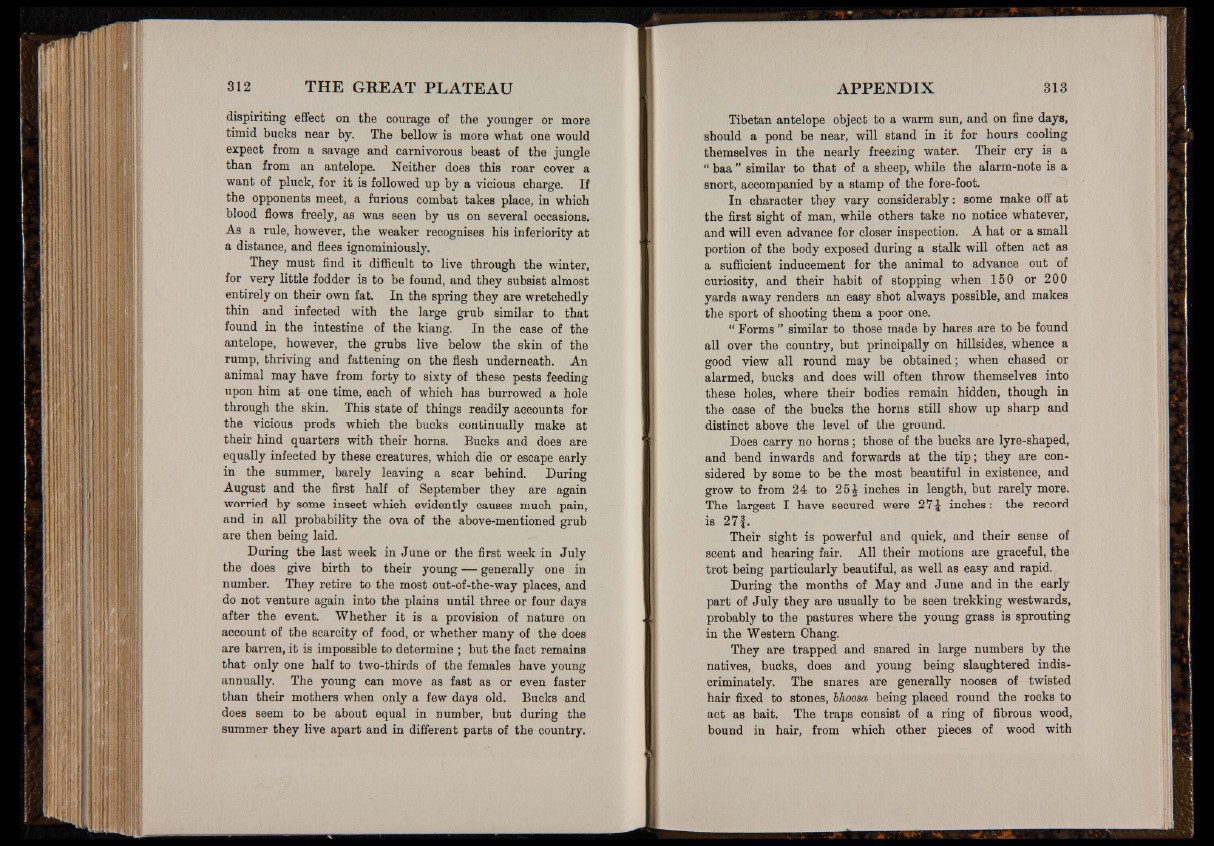
dispiriting effect on the courage of the younger or more
timid bucks near by. The bellow is more what one would
expect from a savage and carnivorous beast of the jungle
than from an antelope. Neither does this roar cover a
want of pluck, for it is followed up by a vicious charge. If
the opponents meet, a furious combat takes place, in which
blood flows freely, as was seen by us on several occasions.
As a rule, however, the weaker recognises his inferiority at
a distance, and flees ignominiously.
They must find it difficult to live through the winter,
for very little fodder is to be found, and they subsist almost
entirely on their own fat. In the spring they are wretchedly
thin and infected with the large grub similar to that
found in the intestine of the kiang. In the case of the
antelope, however, the grubs live below the skin of the
rump, thriving and fattening on the flesh underneath. An
animal may have from forty to sixty of these pests feeding
iipon him at one time, each of which has burrowed a hole
through the skin. This state of things readily accounts for
the vicious prods which the bucks continually make at
their hind quarters with their horns. Bucks and does are
equally infected by these creatures, which die or escape early
in the summer, barely leaving a scar behind. During
August and the first half of September they are again
worried by some insect which evidently causes much pain,
and in all probability the ova of the above-mentioned grub
are then being laid.
During the last week in June or the first week in July
the does give birth to their young — generally one in
number. They retire to the most out-of-the-way places, and
do not venture again into the plains until three or four days
after the event. Whether it is a provision of nature on
account of the scarcity of food, or whether many of the does
are barren, it is impossible to determine ; but the fact remains
that only one half to two-thirds of the females have young
annually. The young can move as fast as or even faster
than their mothers when only a few days old. Bucks and
does seem to be about equal in number, but during the
summer they live apart and in different parts of the country.
Tibetan antelope object to a warm sun, and on fine days,
should a pond be near, will stand in it for hours cooling
themselves in the nearly freezing water. Their cry is a
“ baa ” similar to that of a sheep, while the alarm-note is a
snort, accompanied by a stamp of the fore-foot.
In character they vary considerably: some make off at
the first sight of man, while others take no notice whatever,
and will even advance for closer inspection. A hat or a small
portion of the body exposed during a stalk will often act as
a sufficient inducement for the animal to advance out of
curiosity, and their habit of stopping when 150 or 200
yards away renders an easy shot always possible, and makes
the sport of shooting them a poor one.
“ Forms ” similar to those made by hares are to be found
all over the country, but principally on hillsides, whence a
good view all round may be obtained; when chased or
alarmed, bucks and does will often throw themselves into
these holes, where their bodies remain hidden, though in
the case of the bucks the horns still show up sharp and
distinct above the level of the ground.
Does carry no horns; those of the bucks are lyre-shaped,
and bend inwards and forwards at the tip; they are considered
by some to be the most beautiful in existence, and
grow to from 24 to 25J inches in length, but rarely more.
The largest I have secured were 27J inches: the record
is 27f.
Their sight is powerful and quick, and their sense of
scent and hearing fair. All their motions are graceful, the
trot being particularly beautiful, as well as easy and rapid.
During the months of May and June and in the early
part of July they are usually to be seen trekking westwards,
probably to the pastures where the young grass is sprouting
in the Western Chang.
They are trapped and snared in large numbers by the
natives, bucks, does and young being slaughtered indiscriminately.
The snares are generally nooses of twisted
hair fixed to stones, bhoosa being placed round the rocks to
act as bait. The traps consist of a ring of fibrous wood,
bound in hair, from which other pieces of wood with